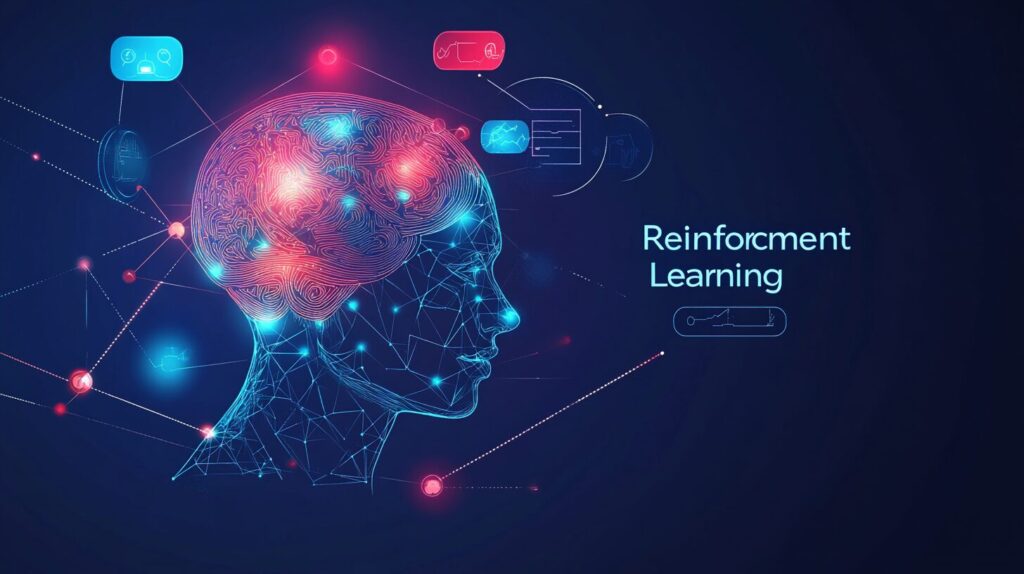In the fast-paced world of financial markets, particularly within the cryptocurrency sector, innovation is the key to staying ahead. One of the most exciting advancements is the application of artificial intelligence (AI), particularly Reinforcement Learning (RL), in trading strategies. Imagine a system that learns from its own experiences, constantly optimizing its actions to achieve the best possible outcome. This is the essence of Reinforcement Learning—a technique that is revolutionizing trading and investment strategies. Argoox, a leader in AI trading bots, harnesses the power of Reinforcement Learning to navigate the complexities of the crypto market with precision.
What is Reinforcement Learning?
Reinforcement Learning is known as a subset of machine learning where an agent learns and adapts to make decisions by performing activities in an environment to increase some notion of cumulative reward. Unlike supervised learning, where the model learns from a dataset of labeled examples, RL is about learning from the consequences of actions. The agent receives feedback as rewards or penalties and adjusts its strategy accordingly. This learning process mimics how humans learn from their successes and mistakes, making it highly effective in dynamic environments like financial markets.
Why is Reinforcement Learning Important in Trading?
Trading in financial markets, especially cryptocurrencies, is highly dynamic and unpredictable. Traditional algorithmic trading relies on predefined rules, which may not adapt well to market changes. Reinforcement Learning, however, offers a flexible and adaptive approach. By continuously learning from market data, an RL-based system can adjust its strategies in real time, identifying patterns and opportunities that static models might miss. This adaptability is crucial in the volatile world of cryptocurrency trading, where conditions can change rapidly.
Basic Concepts of Reinforcement Learning
To understand how RL works, it’s essential to grasp some fundamental concepts:
- Agent: The decision-maker, like a trading bot.
- Environment: It is the external system the agent interacts with, such as the financial market.
- State: A specific situation in the environment.
- Action: Any move the agent takes in response to the state.
- Reward: Feedback from the environment, guiding the agent’s future actions.
- Policy: The strategy that the agent employs to decide on actions.
- Value Function: Estimates how good a particular state or action is in terms of expected rewards.
These concepts form the backbone of how an RL agent operates, making decisions that lead to optimized trading outcomes.
How Does Reinforcement Learning Work?
Reinforcement Learning works through a cycle of observation, action, and learning. The agent observes the existing state of the environment (e.g., market conditions), takes an action (e.g., buy, sell, or hold a cryptocurrency), and then receives feedback in the form of a reward. According to this feedback, the agent updates its policy to improve future decisions. Over time, this process leads to increasingly better decision-making as the agent learns which actions yield the highest rewards under various conditions.
Can Reinforcement Learning Be Used for Trading?
Absolutely. Reinforcement Learning is particularly well-suited for trading due to its ability to handle complex, stochastic environments like financial markets. It allows for the creation of adaptive trading strategies that can respond to market conditions in real-time. Moreover, RL can be used to optimize trading parameters, manage risk, and improve the overall profitability of trading strategies.
Types of Reinforcement Learning Algorithms
There are several types of RL algorithms, each with its own strengths and use cases in trading:
- Q-Learning: A model-free algorithm that learns the value of an action in a particular state.
- Deep Q-Networks (DQN): An extension of Q-Learning using deep neural networks, allowing the agent to handle more complex environments.
- Policy Gradient Methods: These directly optimize the policy, which can be more effective in continuous action spaces like trading.
- Actor-Critic Methods: Combines both value-based and policy-based approaches for improved performance.
Each of these algorithms can be tailored to develop sophisticated trading models that can adapt and optimize over time.
Use Cases of Reinforcement Learning
Reinforcement Learning has numerous applications beyond trading, such as in robotics, autonomous vehicles, and gaming. However, in the financial sector, RL is primarily used for:
- Portfolio Management: Optimizing asset allocation to maximize returns while managing risk.
- Algorithmic Trading: Developing strategies that adapt to market conditions in real-time.
- Market Making: Automating the process of providing liquidity in financial markets.
These use cases highlight RL’s versatility and its potential to transform financial markets.
Reinforcement Learning in Trading Crypto
Cryptocurrency markets are famous for their highly volatile and operate 24/7, making them an ideal environment for RL applications. RL algorithms can be used to develop trading bots that continuously learn and adapt to market trends, optimizing trade execution, and minimizing risks. The ability to process vast amounts of data and make real-time decisions gives RL-powered trading bots a significant edge in the crypto market.
How is Reinforcement Learning Applied in Trading Bots?
In trading bots, Reinforcement Learning is applied through a continuous loop of data processing, decision-making, and learning. The bot receives market data, processes it to determine the current state, and then selects an action based on its policy. After executing the trade, the bot receives feedback in the form of profit or loss, which it uses to refine its strategy. Over time, this process helps the bot to improve its decision-making, leading to better trading outcomes.
Why Use Reinforcement Learning in Trading Bots?
The primary advantage of using RL in trading bots is adaptability. Unlike traditional trading algorithms, which follow predefined rules, RL-based bots can learn from market data and adjust their strategies accordingly. This makes them more resilient to market fluctuations and capable of seizing opportunities that static models might miss. Additionally, RL-based bots can optimize multiple aspects of trading, such as timing, execution, and risk management, leading to improved overall performance.
The Architecture of an RL-Powered Trading Bot
An RL-powered trading bot typically consists of the following components:
- Data Input Layer: Collects and processes real-time market data.
- State Representation: Converts raw data into a format the agent can use to make decisions.
- Policy Network: Determines the best action to take based on the current state.
- Reward Function: Evaluate the success of an action to guide future decisions.
- Learning Algorithm: Continuously updates the policy based on feedback from the market.
This architecture allows the bot to operate autonomously, making informed decisions with minimal human intervention.
What are the Disadvantages of Reinforcement Learning in Creating Trading Bots?
While RL offers many advantages, it also has some drawbacks:
- Complexity: Developing and tuning RL algorithms can be complex and time-consuming.
- Data Requirements: RL requires large amounts of data to train effectively, which can be a barrier for smaller traders.
- Overfitting: There’s a risk of the model becoming too tailored to historical data, leading to poor performance in live trading.
- Computation Costs: RL algorithms can be resource-intensive, requiring significant computational power.
Despite these difficulties and challenges, the potential rewards of using RL in trading bots often outweigh the drawbacks.
How to Build a Reinforcement Learning Trading Bot?
Building an RL trading bot involves several steps:
- Define the Objective: Determine what the bot aims to achieve (e.g., maximize returns and minimize risk).
- Collect Data: Gather historical market data for training.
- Design the Agent: Choose the appropriate RL algorithm and design the policy network.
- Train the Model: By using the collected data, you can train the agent.
- Backtest: Test the bot on historical data to evaluate its performance.
- Deploy: Integrate the bot with a trading platform and begin live trading.
- Monitor and Refine: Continuously monitor the bot’s performance and make adjustments as needed.
Each of these steps is crucial for developing a successful trading bot that can thrive in the crypto market.
Challenges and Considerations
Building and deploying an RL-based trading bot comes with several challenges:
- Market Dynamics: Financial markets are unpredictable, and strategies that work today might not work tomorrow.
- Regulatory Compliance: Ensure the bot operates within the legal framework of the markets it’s trading in.
- Security: Protecting the bot from hacks and unauthorized access is critical.
- Ethical Considerations: Consider the ethical implications of automated trading and its impact on the market.
Addressing these difficulties is crucial for the successful deployment of an RL trading bot.
Case Studies of Reinforcement Learning Trading Bot: Introducing Argoox Trading Bot
One notable example of an RL-powered trading bot is the Argoox trading bot. Leveraging advanced RL algorithms, Argoox offers an AI-driven approach to crypto trading, continuously learning and adapting to market conditions. The bot’s ability to make data-driven decisions in real time sets it apart from traditional trading systems, delivering users with a competitive edge in the volatile crypto market.
Conclusion
Reinforcement Learning represents a considerable leap forward in trading technology, offering a dynamic and adaptive approach that is well-suited to the complexities of financial markets, especially cryptocurrencies. By integrating RL into trading bots, traders can achieve superior results through real-time strategy optimization. As demonstrated by the Argoox trading bot, the future of trading lies in AI-driven systems that can learn and evolve. To stay ahead in the competitive world of cryptocurrency trading, explore the innovative solutions offered by Argoox, a global leader in AI trading bots.




